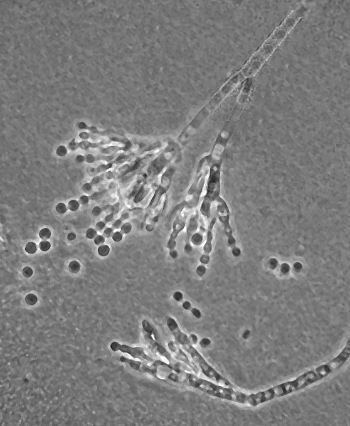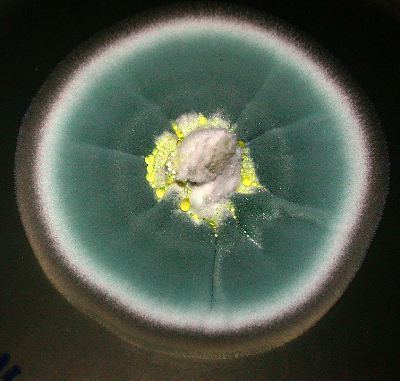Rank Species | Higher classification Penicillium | |
 | ||
Similar Penicillium, Aspergillus niger, Cladosporium, Rhizopus, Cladosporium herbarum | ||
Penicillium chrysogenum or P. notatum (formerly) is a species of fungus in the family Trichocomaceae. It is common in temperate and subtropical regions and can be found on salted food products, but it is mostly found in indoor environments, especially in damp or water-damaged buildings. It was previously known as Penicillium notatum. It has rarely been reported as a cause of human disease. It is the source of several β-lactam antibiotics, most significantly penicillin. Other secondary metabolites of P. chrysogenum include roquefortine C, meleagrin, chrysogine, xanthocillins, secalonic acids, sorrentanone, sorbicillin, and PR-toxin.
Contents
- Medical vocabulary what does penicillium chrysogenum mean
- Science and history
- Genetics and evolution
- References

Like the many other species of the genus Penicillium, P. chrysogenum usually reproduces by forming dry chains of spores (or conidia) from brush-shaped conidiophores. The conidia are typically carried by air currents to new colonisation sites. In P. chrysogenum, the conidia are blue to blue-green, and the mold sometimes exudes a yellow pigment. However, P. chrysogenum cannot be identified based on colour alone. Observations of morphology and microscopic features are needed to confirm its identity and DNA sequencing is essential to distinguish it from closely related species such as Penicillium rubens. The sexual stage of P. chrysogenum was discovered in 2013 by mating cultures in the dark on oatmeal agar supplemented with biotin, after the mating types (MAT1-1 or MAT1-2) of the strains had been determined using PCR amplification.

The airborne asexual spores of P. chrysogenum are important human allergens. Vacuolar and alkaline serine proteases have been implicated as the major allergenic proteins.

P. chrysogenum has been used industrially to produce penicillin and xanthocillin X, to treat pulp mill waste, and to produce the enzymes polyamine oxidase, phosphogluconate dehydrogenase, and glucose oxidase.

Medical vocabulary what does penicillium chrysogenum mean
Science and history

The discovery of penicillin ushered in a new age of antibiotics derived from microorganisms. Penicillin is an antibiotic isolated from growing Penicillium mold in a fermenter. The mold is grown in a liquid culture containing sugar and other nutrients including a source of nitrogen. As the mold grows, it uses up the sugar and starts to make penicillin only after using up most of the nutrients for growth.
Penicillin was discovered in 1928 when Alexander Fleming's lab assistant accidentally left a window open overnight and mold spores covered his Staphylococcus bacterial specimens in a Petri dish. At first, Fleming was very irritated at the contamination, but as he was about to throw the specimens away, he noticed something interesting. He looked under the microscope at the bacteria surrounding the blue-green mold and noticed that many were dead or dying. This later turned out to have been due to the mold's prevention of the bacteria from making new cell walls and reproducing. He identified the mold as Penicillium notatum, which releases the antibiotic penicillin G into the medium (his identification has been subsequently shown to be incorrect: the fungal species was actually the related P. rubens). After this, he did some testing on humans and animals and discovered that not only did it kill bacteria, but it was also suitable for use as a medication in humans and animals. However, the discovery did not attract much attention until the 1940s, when Howard Florey, Norman Heatley, and Ernst Chain developed methods for mass production and application in humans, incited by the urgent war-time need for antibacterial agents. The work of Andrew J. Moyer was important in these early developments.
At this point, though the drug had shown success in treating numerous bacterial diseases, it was still so difficult to produce and so dilute that it was not feasible to produce quantities large enough for mass production, so an effort was begun to find a strain of Penicillium with a higher rate of production of penicillin. Army pilots sent back soil from around the world to be tested for the right kind of mold. Even the people of Peoria, Illinois, were told to bring in any molds that they found around their homes. P. chrysogenum was discovered by these means, on a cantaloupe from a grocery store in Peoria, Illinois. The fungus isolated from this cantaloupe produced several hundred times as much penicillin as Fleming's original cultures. Subcultures of this fungus were then irradiated with X-rays and UV rays in an attempt to cause a mutation in the fungus that would lead to an increase in penicillin yield. The effort was successful, and a mutant strain that yielded more than a thousand times the penicillin of Fleming's original culture was produced and cultured. This discovery, in combination with vastly improved methods of culturing the fungus based on the principle of aerating the culture medium, resulted in the ability to mass-produce penicillin in quantities great enough for distribution and mass use in the United States Army, and also in the British army during the World War II and also in the Crimean war specifically for healing the armies of Italy.
Genetics and evolution
The ability to produce penicillin appears to have evolved over thousands or millions of years, and is shared with several other related fungi. It is believed to confer a selective advantage during competition with bacteria for food sources. Some bacteria have consequently developed the counter-ability to survive penicillin exposure by producing penicillinases, enzymes that degrade penicillin. Penicillinase production is one mechanism by which bacteria can become penicillin resistant.
The principal genes responsible for producing penicillin, pcbAB, pcbC, and penDE are closely linked, forming a cluster on chromosome I. Some high-producing Penicillium chrysogenum strains used for the industrial production of penicillin contain multiple tandem copies of the penicillin gene cluster.
